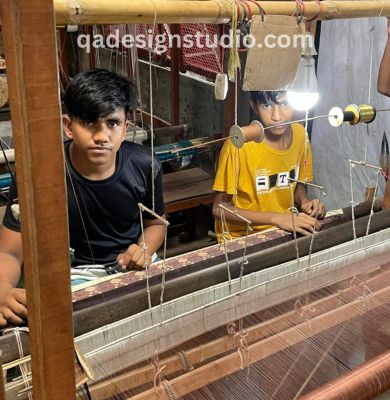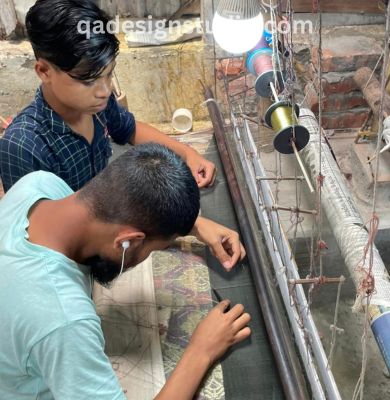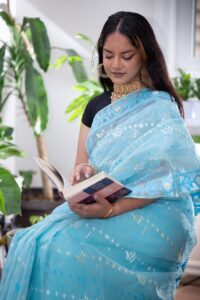Bangladeshi Jamdani sarees are renewing worldwide for their intricate designs, delicate craftsmanship, and rich cultural heritage. But Identifying Bangladeshi Jamdani Sarees is a little bit problem. Don’t worry we are for you. Originating from the ancient region of Bengal. These sarees have a history that spans centuries. The word “Jamdani” derive from the Persian term “Jamdani,” meaning “flower vase” or “flower-filled field,”. Which aptly describes the exquisite motifs and floral patterns adorning these beautiful garments. In this blog, we will explore the key characteristics, weaving techniques. And cultural significance of Bangladeshi Jamdani sarees, highlighting their unique identity in the world of textiles.
Historical Background
The roots of Jamdani sarees can trace back to the ancient region of Bengal, encompassing present-day Bangladesh. This textile art form flourished during the Mughal era (16th-18th centuries), reaching its pinnacle of excellence under royal patronage. The weaving of Jamdani sarees requires exceptional skills. The craft is pass down through generations within artisan families. Recognizing its cultural importance, UNESCO declared Jamdani weaving as an Intangible Cultural Heritage of Humanity in 2013, acknowledging its significant contribution to the world of textiles.
Characteristics of Jamdani Sarees
Obviously, Bangladeshi Jamdani sarees renown for their unique features and intricate designs. They are typically made from fine-quality cotton or silk threads, resulting in a lightweight, breathable fabric. The hallmark of a Jamdani saree lies in its elaborate motifs, often inspired by nature, including flowers, leaves, vines, and geometric patterns. These motifs are meticulously woven into the fabric, creating an almost ethereal effect.
However, The weaving technique use in Jamdani sarees involves the supplementary weft technique. Where the design is woven using an additional weft thread. The weavers meticulously interlace the extra thread with the main warp and weft, giving rise to the intricate patterns that appear to float on the fabric. This delicate process requires great skill, precision, and countless hours of labor, making each Jamdani saree a work of art.
Traditional Weaving Techniques

Firstly, The creation of Jamdani sarees involves a meticulous and time-intensive weaving process. Traditionally, this art form was parting in small weaving villages. Where artisans dedicated themselves to preserving and advancing the craft.
The first step in creating a Jamdani saree involves preparing the loom. Which consists of a vertical frame. The weaver sets up the warp threads, which run lengthwise, and ties them to the loom. The number of warp threads determines the width of the fabric.
The weaving process is slow and requires immense concentration. The weaver must manually select the appropriate thread from the tara, insert it through the warp threads, and secure it tightly. This meticulous process repeats for every motif, resulting in a fabric that adorns with an array of intricate designs. Once the loom is set up, the weaver begins the weaving process.
The supplementary weft threads, which carry the motifs, are wound onto small bobbins called “tara.” The weaver skillfully interlaces these bobbins into the fabric, following the design chart known as the “naksha.” The naksha acts as a guide for the intricate patterns and motifs, ensuring their precise placement.
Cultural Significance and Contemporary Adaptations
Basically, Jamdani sarees hold immense cultural significance in Bangladeshi society. It is often worn during special occasions, festivals, and weddings, symbolizing tradition, elegance, and grace. The intricate motifs and craftsmanship showcase the artistic prowess of the weavers, and owning. A Jamdani saree considers a matter of prestige.
Overall, Jamdani sarees have evolved to incorporate contemporary elements while retaining their traditional essence. Today, we find variations in design, color, and fabric, catering to diverse tastes and preferences. The use of vibrant hues, metallic threads, and innovative motifs has expanded the appeal of Jamdani sarees to a wider audience. The revival of Jamdani weaving has also led to economic empowerment. And the preservation of traditional skills. Artisan cooperatives and organizations has established to provide support, training, and fair wages to weavers, ensuring the sustainability of this art form. Furthermore, initiatives such as design collaborations, fashion shows, and exhibitions have helped promote Jamdani sarees on the global stage. It is introducing a new generation to their timeless beauty.

Conclusion
Additionally, If you want to Identifying Bangladeshi Jamdani Sarees you have to mind it that. Bangladeshi Jamdani sarees are not just garments. It’s a testament to the rich cultural heritage and craftsmanship of the region. With their intricate motifs, delicate weaving, and vibrant colors. These sarees continue to captivate people worldwide. The dedication of the artisans, the historical significance, and the contemporary adaptations have allowed Jamdani sarees to thrive and retain their identity in the modern era. As we celebrate this timeless textile art. It is essential to appreciate and preserve the legacy of Jamdani weaving for future generations. It ensuring that its splendor continues to shine brightly.


